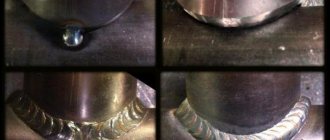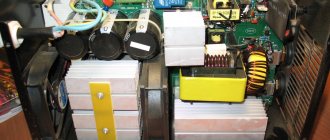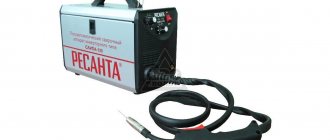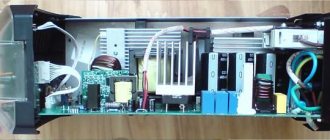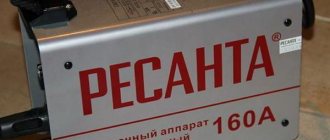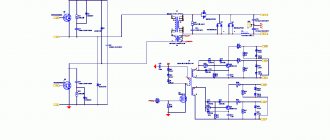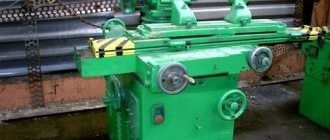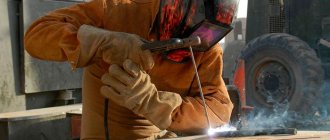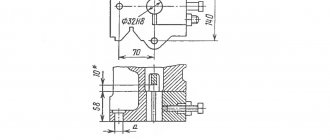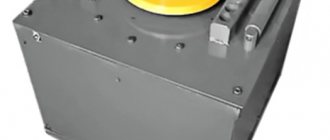How the Resanta SAI-190 welding machine works
To adjust the welding current, a pulse width modulator is installed on the Resanta SAI-190 machine. The operating circuit of the inverter is the conversion of alternating current into direct current. The voltage of the first is 50 Hz. Then the constant becomes variable again with high frequency rates. The device includes several important functions:
Welding machine Resanta SAI 190
- Anti Stick - prevents sticking of the working electrode;
- Hot Start - helps you quickly and easily start welding;
- automatic overheating protection - minimizes the risk of a short circuit.
The latter function provides a special signal light. It comes on when the inverter unit is overheating and needs a short break. The situation requires an immediate stop in welding for 15 minutes. There is no need to disconnect the inverter from the network.
Together, all systems of the unit provide comfortable and high-quality work, even for a beginner. Compared to other welding inverters, Resanta SAI-190 significantly saves energy and provides high efficiency.
Scheme and repair
If you don’t want to send the welder in for repairs and want to figure it out yourself (after all, the diagram is not that complicated), then you need to find and study the diagram and faults of the RESANTA SAI 190. If you have experience, then you don’t have to use the diagram at all, which is only needed for convenience and quick search malfunctions. To illustrate the example, a diagram of an inverter-type welder RESANTA SAI 220 (190) is shown, and the main radio elements that often fail are noted.
Scheme 1 - Electrical diagram of the welding inverter Resant SAI 220.
To repair the device, you need to understand typical faults and how to eliminate them.
Typical faults
Sometimes an inverter-type welding machine malfunctions. The causes and consequences can be varied. If possible, you should take it in for repairs. However, many will want to do it themselves. Thanks to this solution to the issue, you can increase your knowledge in the field of electrical engineering, because there are a lot of electrical devices and you can significantly save on their repair. Faults should be classified into simple and complex. Simple ones include:
Overheating due to dust.- Broken wires.
- Loss of power (due to wet housing).
- Punching the mass onto the body.
- Bad contacts.
- Electrode sticking.
Any electrical device does not like dust, since it impedes the transfer of heat and is a conductor of current (possibly a short circuit). Even with high-quality cleaning of the room, there will still be dust. Regular maintenance can not only extend the life of the devices, but also protect you from many financial and repair problems.
Wire breaks occur in places that are subject to constant bending. Kinking wires are very difficult to track and often lead to short circuits. In addition, the contacts on the pads holding the electrode become loose, making welding of lower quality or impossible. Periodically, all contacts need to be tightened.
Instructions for using the Resanta SAI-190 inverter
Control panel for welding machine Resanta SAI 190
Connecting the device to the network does not require compliance with specific rules. The outlet must be grounded, since the protective grounding occurs through the electrical cord. The manufacturer indicated in the instructions that for correct operation, the value of the installed machines should not be less than 16 A. If the device was left outside for a long time at sub-zero temperatures, it should be left indoors at room temperature for at least 2 hours.
It is unacceptable to use the Resanta device in conditions of high humidity or in the rain. It is important to avoid dusty work near the welding machine. Grinders, electric saws or grinders should not be used in the same room as the welding device. For safety reasons, do not cover the inverter, even if it is running idle. Continuous operation should last no more than 70% of the total time: out of 10 minutes of work, 3 minutes are allocated for cooling the device.
Inverter technical data
The main advantage of this welding inverter for the home needs of consumers is that it is specially adapted for connection to those electrical networks in which there is a low voltage (130-250 Volts) .
Resanta SAI operates without interruption at the specified voltage when welding in manual arc mode. You can use welding rods with a cross-section of up to 6.0 millimeters. The welding current in the device can be adjusted up to 250A. It is also important that the device is capable of withstanding quite large workloads for a long time. This property positively distinguishes its operating scheme from other devices that are found in abundance in the windows of specialized hardware stores.
At idle, the Resanta SAI welding device operates with a voltage of 80 Volts. The durability of the device at fairly high power is ensured in its circuit by the design of modern high-quality IGBT transistors. In addition, this welding inverter has a high degree of protection - IP 21 protection level.
It is impossible not to mention the compactness of this welding machine, as well as its excellent mobility. Equipping the device with a carrying handle makes it easier to carry it around the site where construction is taking place. Consumers also note the accuracy and ease of setting up the Resanta Sai welding inverter. At the same time, the specified indicators are guaranteed to retain the established data even in cases where the electrical network is not stable in its voltage indicators.
The technical characteristics of the Resanta SAI device we are interested in are as follows:
- maximum current consumption – 35 Amperes;
- load duration at 250 Amps – not less than 70%;
- welding adjustment interval – 10-250 Amperes;
- operating ambient temperature range – -10/+40С;
- electric arc voltage – 30 Volts.
If necessary, this device can be connected to the equipment of a generator that runs on gasoline. It is best to choose a generator with a power above five kilowatts.
Attention! When choosing a welding electrode (the electrode can have a diameter of no more than 6 millimeters), it is also necessary to take into account that the welding current decreases when the input current decreases.
Technical parameters of Resanta SAI-190
The Resanta SAI-190 kit includes two power cables 2 and 1.5 meters long, an electrical holder, and a grounding terminal. Main technical parameters of the inverter:
| Characteristics | Values | Unit measurements |
| Welding arc voltage | 27 | V |
| Total weight | 2700 | G |
| Inverter dimensions | 0.15x0.3x0.37 | m |
| Maximum current during welding | 25 | A |
| Metal case protection | IP21 | — |
| Required mains voltage | 220 | V |
| Allowable electrode diameter | 5 | mm |
| Power level | 5 | kW |
| Idling | 80 | V |
| Cooling method | air | — |
A more advanced model, Resanta SAI-190 Prof., is in great demand among professional welders. The key difference is the presence of the ARC FORCE function, which makes it possible to control the current during the welding process from 10 to 190 A. The mains voltage is acceptable in the range from 100 to 260 V. The maximum current has been increased to 33 A.
The main advantages and disadvantages of the inventor Resanta Sai-190
The Resanta model belongs to a number of semi-industrial devices, since it can be used at home and on an industrial scale with equal efficiency. The device is considered quite mobile, as it is light in weight and relatively small in size. Excellent performance, low consumption of electrodes and electricity, simple regulation are the main advantages of the inverter. The device allows you to weld different types of metals.
Technical parameters of SAI-190 in comparison with other Resanta welding machines
Many welders note a significant drawback - the cable is too short, which limits the possibilities for welding work. In addition, the electric device does not tolerate humidity and cold, which makes it necessary to take into account climatic conditions. If this recommendation is ignored, the welding inverter will quickly fail. What is also important: the cost of the device exceeds most analogues with similar characteristics.
Despite certain disadvantages, the modern inverter is in great demand. The device is made in China, but has good repairability. Most breakdowns are associated with non-compliance with operating rules. To ensure high-quality and stable work, it is recommended to adhere to all recommendations specified in the instructions. You should focus on caring for equipment - removing dust and accumulated dirt.
Malfunctions of the Resanta Sai-190 unit
If the welding machine fails, it is recommended to contact a specialized workshop for repair. Soldering failures and burnt parts can be identified by visual analysis. Other cases require careful diagnosis. The most common problems:
Common malfunctions in the operation of SAI-190
- if the fan of the device breaks down or a large amount of dust accumulates inside, the device quickly heats up;
- damage to the cable or switch results in a lack of power;
- If the printed circuit board burns out, the cord is damaged or there is a loss of mass, there is no arc.
The welding inverter Resanta SAI-190 ensures stable operation, even with voltage fluctuations in the electrical network. The higher the power of the welding machine, the easier it will be to weld at low voltage. Accordingly, the higher the current strength of the device, the higher its price. By choosing the optimal model, you can get an indispensable assistant on the farm or in an industrial enterprise.
Related video: Resanta SAI-190A
Publications on the topic
How to independently repair inverter-type welding machines
Features of choosing the best inverter welding machine
Getting to know the best Russian-made welding inverters
Inverter type welder
Old transformer modifications of the welding machine have a very low price, high repairability, but have significant disadvantages: dimensions, significant weight and dependence on the mains voltage. The output current of the electronic meter is limited by electricity consumption to 4.5 kW. For welding work when using thick metals, current consumption increases, and this process places a significant load on old power lines, which also contain strands (after all, in the former CIS countries they are rarely replaced with new ones).
They have been replaced by inverter-type welding machines, the operating features of which are significantly different.
Features of operation
The scope of application is varied, ranging from households to enterprises. The main task is to ensure stable combustion and maintenance of the welding arc when performing welding work, thanks to the use of high frequency current. The operation of the welding inverter is based on the principles:
- Conversion of alternating input voltage 220 V to direct (direct current is converted into high-frequency alternating current of a non-sinusoidal nature).
- Subsequent rectification of the high-frequency current (frequency is maintained).
Thanks to these principles, there is a significant reduction in the weight and dimensions of the inverter, which makes it possible to additionally integrate cooling.
Operating principle and main characteristics
To troubleshoot inverter welding machines, you need to familiarize yourself with its block diagram. It consists of the following elements:
- Rectifier.
- Inverter.
- Transformer.
- High frequency rectifier.
- Control and stabilization circuit (driver and control board).
- Welding current regulator.
Thanks to this device, weight and dimensions are reduced. The use of a pulse transformer allows you to obtain powerful currents in the secondary winding. Consequently, the welding inverter is an ordinary switching power supply, like in a computer, but with quite a lot of power. As the frequency increases, the mass and dimensions of the transformer decrease (inversely proportional). To obtain high frequencies, powerful key transistors are used.
Switching occurs with a frequency from 30 to 100 kHz (depending on the SAIPA model). Transistors only operate from direct voltage (U), converting it into high frequency current. The result is a direct current from the rectifier (rectification of the mains voltage 50 Hz). In addition, the rectifier includes a capacitor filter. When current is passed through the diode bridge, the negative amplitudes of the alternating U are cut off (the diode passes current only in one direction). Positive amplitudes are not constant and a constant U is obtained with noticeable ripples, which must be smoothed out using a large capacitor.
